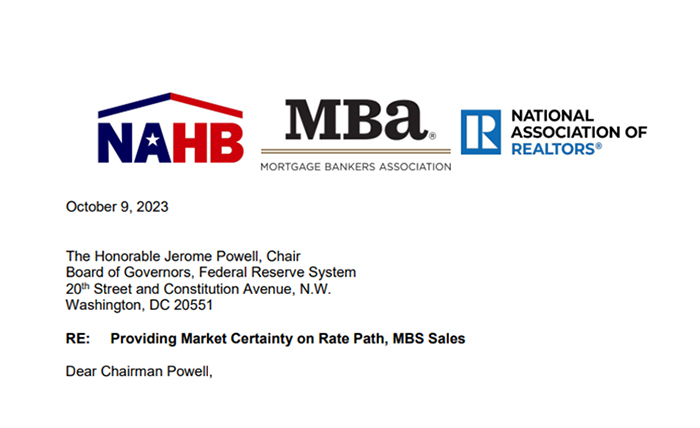
MBA, Housing Trades Call on Fed to End Rate Hikes, Pledge Not to Sell MBS Book

On Monday, the Mortgage Bankers Association led a coalition letter sent to the Board of Governors of the Federal Reserve that conveyed the housing industry’s serious concerns about the negative market impacts the Fed’s monetary policy actions (e.g., rate hikes and quantitative tightening) are having on the market. Fed policy has created market uncertainty and volatility, driving the spread between the 10-Year Treasury and 30-year fixed-rate mortgage to historically high levels and in turn reducing homes sales activity. The letter was also signed by the National Association of Home Builders (NAHB) and National Association of Realtors (NAR). See the full text below:
The Mortgage Bankers Association (MBA), National Association of Realtors (NAR), and National Association of Home Builders (NAHB) write today to the Board of Governors of the Federal Reserve System (hereinafter “the Fed”) to convey profound concern shared among our collective memberships that ongoing market uncertainty about the Fed’s rate path is contributing to recent interest rate hikes and volatility. This has exacerbated housing affordability and created additional disruptions for a real estate market that is already straining to adjust to a dramatic pullback in both mortgage origination and home sale volume. These market challenges occur amidst a historic shortage of attainable housing.
According to MBA’s latest Weekly Applications Survey data, mortgage rates have now reached a 23-year high, dragging application activity down to a low last seen in 1996. The speed and magnitude of these rate increases, and resulting dislocation in our industry, is painful and unprecedented in the absence of larger economic turmoil.
Today, the spread between 30-year mortgage rates and the 10-year Treasury yield is at historically high levels, signaling deep-seated uncertainty about where the Fed is headed.
The difference between the current spread and the long-run average indicates mortgage rates for homebuyers across the country that are at least 120 basis points higher than they otherwise would be. In other words, the uncertainty-induced mortgage-to-Treasury spread is costing today’s homebuyers an extra $245 in monthly payment on a standard $300,000 mortgage. Further rate increases and a persistently widespread pose broader risks to economic growth, heightening the likelihood and magnitude of a recession.
Furthermore, a leading source of inflation in recent months has been increases in shelter costs. In the August CPI report, consumer prices were up 3.7%, while shelter costs were up 7.3%. In July, shelter inflation was responsible for 90% of the gain for consumer prices. The most effective approach to tame shelter costs, and assist on the broader inflation fight, is to facilitate the construction of attainable, affordable housing. Sustained wide spreads or further increases in interest rates make this economic goal more challenging by limiting lot development and home construction, exacerbating housing supply, and pricing out millions of households from the goal of homeownership.
We strongly urge the Fed to make two clear statements to the market:
• The Fed does not contemplate further rate hikes;
• The Fed will not sell off any of its MBS holdings until and unless the housing finance market has stabilized and mortgage-to-Treasury spreads have normalized.These steps will provide the market greater certainty about the Fed’s rate path and its plans for the MBS portfolio and reduce volatility for traders and investors.
Housing activity accounts for nearly 16% of GDP according to NAHB estimates. We urge the Fed to take these simple steps to ensure that this sector does not precipitate the hard landing the Fed has tried so hard to avoid.
